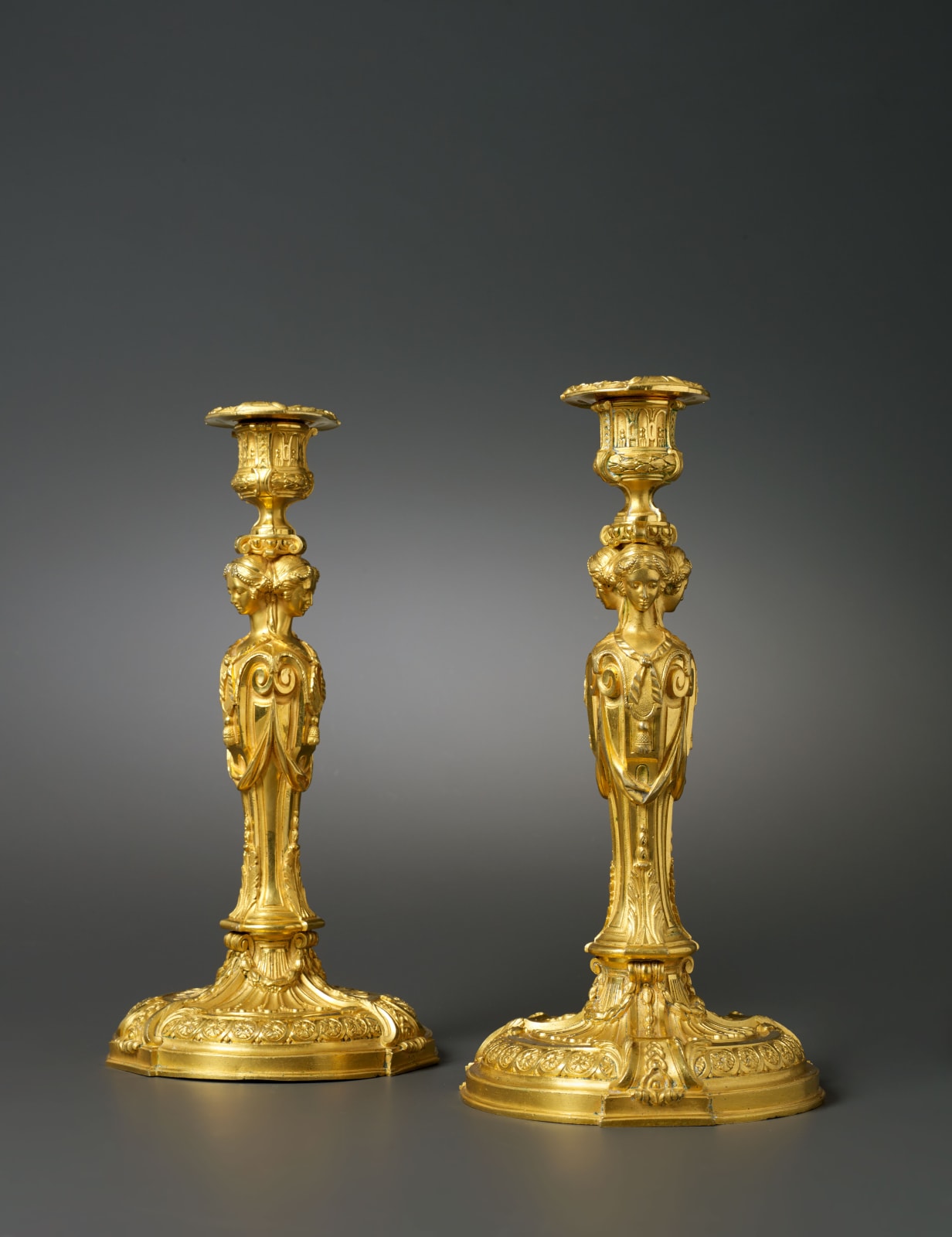Jean-Démosthène Dugourc (after)
Literature
Hans Ottomeyer and Peter Pröschel, “Vergoldete Bronzen”, 1986, p. 286, pl. 4.15.2, illustrating a comparable candlestick dating from circa 1785 in Schloss Pillnitz, Dresden and pl. 4.15.3, illustrating a candlestick of a similar model with four caryatid herms by Pierre Gouthière, circa 1785. Peter Hughes, “The Wallace Collection Catalogue of Furniture”, 1996, pp. 1232-36, no. 243 (F164-5), illustrating and describing a pair of comparable candlesticks of 1781 featuring three female caryatid terms with differing vase-shaped candle nozzles and dolphins on the bases by Claude-Jean Pitoin, in the Wallace Collection, London and pp. 1246-50, no. 246 (F174-5), describing and illustrating another comparable pair of candlesticks with four female caryatid terms and differing nozzles of circa 1783 in part by François Rémond from a model he supplied in 1783 and 1786 to the marchand-mercier Dominique Daguerre. Alan P. Darr et al, “The Dodge Collection of XVIII Century French and English Art in the Detroit Institute of Arts”, 1996, p.131 (71.216, 71.217), illustrating a comparable but later pair of candlesticks of circa 1850-1900, in the Detroit Institute collection. Giacomo et Rozenn Wannenes, “Les Bronzes Ornementaux et Les Objets Montes de Louis XIV à Napoléon III”, 2004, p. 229, illustrating an almost identical pair of gilt bronze candlesticks, which were sold in Paris in 1983.
An extremely fine pair of Louis XVI gilt bronze candlesticks after a model by Jean-Démosthène Dugourc, each with the upper part of their stems formed from three conjoined caryatid maidens with beads in their long hair and braids that tie up below their necks, at the junction of their shoulders and the point that each caryatid term joins are volutes that run the length of the tapering baluster candlestick stem, around which hangs a draped swag, the stems on raised circular bases with foliate swags hanging from the upper part of the base which has three raised ribs, in between which is fluting above a border of rosettes, the caryatid terms supporting on their heads a thin platform with three scrolls upon which is a finely cast vase-shaped candle nozzle and surmounting drip pan
Paris, date circa 1785
Height 30 cm. each.
With their triple female caryatid tapering baluster-shaped stem, these candlesticks bear close similarity to a design attributed to Jean- Démosthène Dugourc (1749-1825) in the Musée des Arts Décoratifs, Paris (illustrated in Ottomeyer and Pröschel, op. cit, p. 287, pl. 4.15.6). The drawing was included in an album of designs for furniture subsequently delivered to both Madame Elizabeth and the comte de Provence, and inscribed Dessiné par J. D. Dugourc, architecte et dessinateur Du Cabinet de Monsieur Frère Du Roi. Paris. 1790. The album depicts both executed and projected designs, several of which reflect the interest in the Arabesque and Etruscan styles that were fashionable during the early 1780s.
In particular, the sheet portrays models for similar candlesticks, the first of which are believed to have been originally supplied to the marchand-mercier Dominique Daguerre by the ciseleur-doreur François Rémond (1747-1812), who on 26th June 1783 invoiced Daguerre as follows: Pour fonte, facon Et Dorure mate d’une pre de grands flambeaux a 4. Figures, Et a guirlandes et fleur, Etc 1050 and again on 28th April 1786: Pour fourniture d’une paire de grande flambeaux a quatre Cariathide doré dor mat 800 (Peter Hughes, op. cit, p. 1249, F174-5). They and the pair, in part by François Rémond, in the Wallace Collection differ in certain respects to the present pair since there are four rather than three caryatid terms at the top of the stem and they also have human feet below. Furthermore, the latter are raised on a domed base and also the vase-shaped candle nozzles are fluted and rest on an octagonal plinth. Despite the differences the overall concept remains the same especially the volutes at the top of the stem. The Wallace Collection also owns another comparable pair of candlesticks which have three female caryatids but different nozzles and are mounted on the bases by three dolphins (P. Hughes, op. cit., pp. 1232-35, F164-5); they, along with a matching pair of candlesticks, were delivered by the bronzier Claude-Jean Pitoin (maître doreur 1778) for the Cabinet de la Méridienne of Marie-Antoinette at Versailles in 1781. One can also cite a set of four candlesticks attributed to François Rémond of a related design in the Wallace Collection of circa 1784-6, each with the stem composed of three classical caryatids in full dress but with differing nozzles and bases (P. Hughes, op. cit., pp. 1259-63, F170-73).
Despite the differences between the various models it can be safely assumed that the original design for this type of candlestick was by Jean Démosthène Dugourc. One of the most famous French draughtsmen working in ornamental design during the second half of the eighteenth century, Dugourc was appointed Architecte et Déssinateur du Cabinet de Monsieur (the brother of Louis XVI) in 1780. The following year he furnished designs for costumes and decorations for the Royal Opera in Stockholm. In 1783 he was appointed Directeur des costumes à decors de l'Opéra in Paris and in that same year became Déssinateur de Garde Meuble de la Couronne.
